Editor’s Note: This article was originally published in Overland Journal’s Fall 2021 Issue.
Photography by Jason Spafford
At the tail end of Hurricane Dorian, a fierce wind battered our ferry as we pitched and rolled through the chop, blown into a white-capped frenzy. Two days of being tossed up and down in the North Atlantic, we anchored with gratitude to an island tucked between Norway and Iceland. Connected by causeways, bridges, and mountains gift-wrapped in a velvety green, heathland ran unbridled through every windswept valley.
Just an hour’s flight from Edinburgh, Scotland, the Faroe Islands is a self-governed land of Denmark. Formed on basalt layers some 60 million years ago, it comprises 18 rocky, volcanic islands of barely trammelled stomping ground—70 miles long, 47 miles wide. No point on these islands is more than three miles from the sea. Until Instagram gives this hidden pearl the same exposure as Iceland, it has to be one of the Nordics’ best-kept secrets.
The Vikings colonised the islands in the 9th century, and the name Tórshavn is a nod to the Nordic God of Thunder. What began as a marketplace later became a bustling town, and today, Tórshavn is one of the smallest capitals in the world. Forget traffic-clogged roads and throngs of tourists; life is unhurried here with a sense of well-being. Incredibly, the prime minister’s number is in the phone book, buses in the capital are free, and there are as many traffic light sets as hostels: three.
Fetchingly, the close-knit archipelago’s population is a shade north of 50,000. Sheep, used as constant lawnmowers, outnumber the locals nearly 2:1. Despite the small human populace, there are 80 nationalities. Such diversity partly stems from when male Vikings settled here without their Norwegian female counterparts in tow, instead scooping up women from Scotland and Ireland.
The Faroe Islands’ coasts are adorned with a wide-open greenbelt sloping on the eastern side and some of Europe’s highest cliffs to the west. There is no litter—just pretty villages full of colour. Inky waters rush into pristine fjord shores, lashing their full power against great shards of rock. We submerged into our desolate surroundings, yomping all over the verdant hills, and got lost in the feeling of being far from society, a place where land and sea wage an endless battle. Solitude overrides loneliness, and with only the natural beauty of small island geographies for company, made the perfect travelling companion.
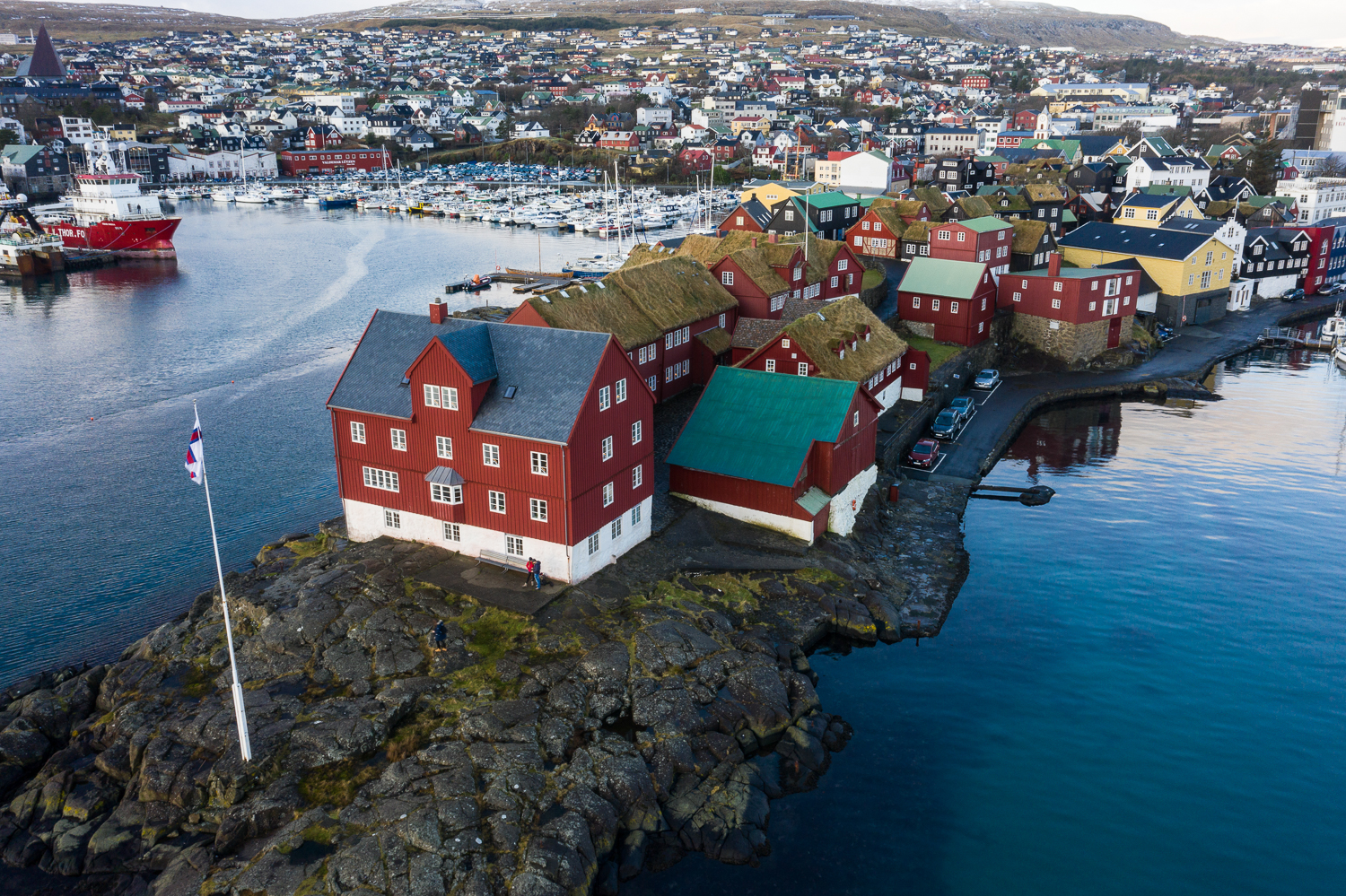
Visas
Part of the Danish Realm, the Faroes fall under Denmark’s immigration rules. As such, any Nordic resident, German, or Italian need only flash their photo ID card to gain entry. EU citizens and those from Schengen countries (a zone of 26 European countries) don’t need visas but are required to show their passports. A Faroes-specific visa is mandatory for those from all other countries (nyidanmark.dk/en-GB) and possession of a valid passport. If the latter is you, find your nearest Danish embassy or consulate: um.dk/en/about-us/organisation/find-us-abroad.
Weather/When to Go to the Faroe Islands
At 62°N, smack dab in the North Atlantic and the Gulf Stream, the Faroes are isolated and harsh and can therefore be chilly year round; bring layers. You’ll get glorious sunshine, cats and dogs rain, and a hooley all on the same day. Temperatures tend to dip to a mild 37°F in wintertime, lacing the landscape in a beautiful dusting of snow and rise to a cool 54°F during the summer. Around 300 rainy days per year call for Gore-Tex, but despite the drizzle, the fresh air will blow away every cobweb. Weather permitting, the northern lights grace the night skies from September through April.
Have a map (or map app) and access to the weather forecast (lv.fo) at all times. When the weather turns, it’s good to orientate yourself and seek refuge. Sometimes, you only need to wait 10 minutes before skipping towards a rainbow.

Overlanding
The infrastructure on the Faroes is better than you might think for such a remote location, connecting every tiny village and cutting through rugged terrain by road or by ferry (schedules at ssl.fo). Serpentine roads hug the hillside as they steepen or diminish to a single lane through a series of terrifying tunnels. On a bus trip (averaging $92), in your vehicle or a rented one, or astride two wheels, you can travel south-to-north within a few hours.
A system of roads, bridges, and sub-sea toll tunnels link the island of Vágar with Streymoy and Bordoy to Eysturoy, making it easy to get from A to B. Roads are well-signed, typically maintained in a good state of repair. Highways are paved, although the roads leading to the smaller villages become narrow and turn to gravel; they should be navigated with care. That said, 4WD is not necessary, and off-roading is prohibited in this fiercely protected rural landscape.
It’s no surprise to learn that the law requires headlights on day and night, and right-hand driving is practiced. Lay-bys (extended sections off to one side) keep the road free for oncoming traffic to pass safely, but don’t be tempted to park up in these. Keep a beady eye out for sheep on the road, often the root cause of a short traffic jam. Studded tyres are permitted between mid-October through April.
Car rental companies can be found at Vágar Airport or Tórshavn with a wide range of options. Note that gas stations are only on Streymoy, Eysturoy, Bordoy, Suðuroy, Vágar, and Sandoy.
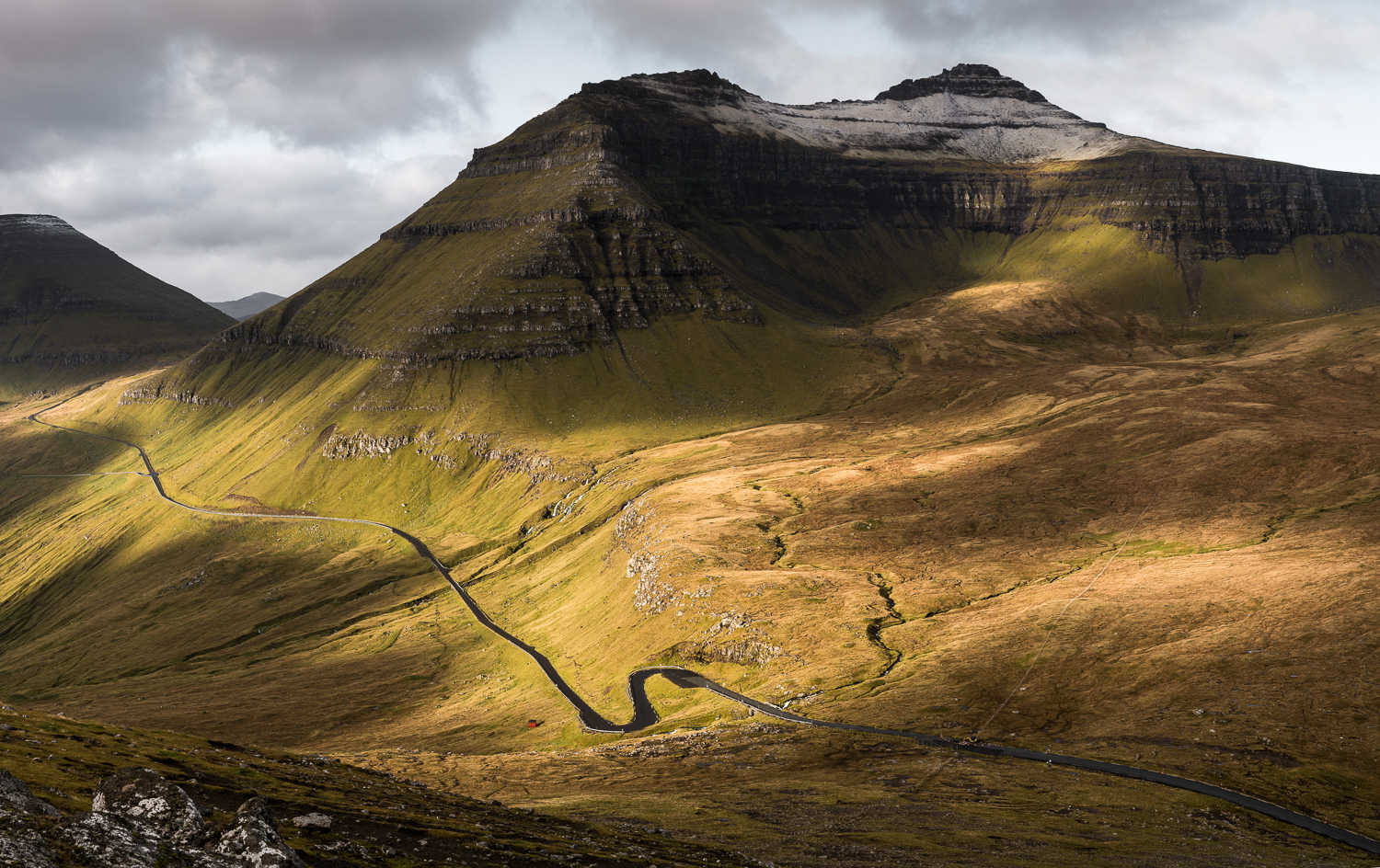

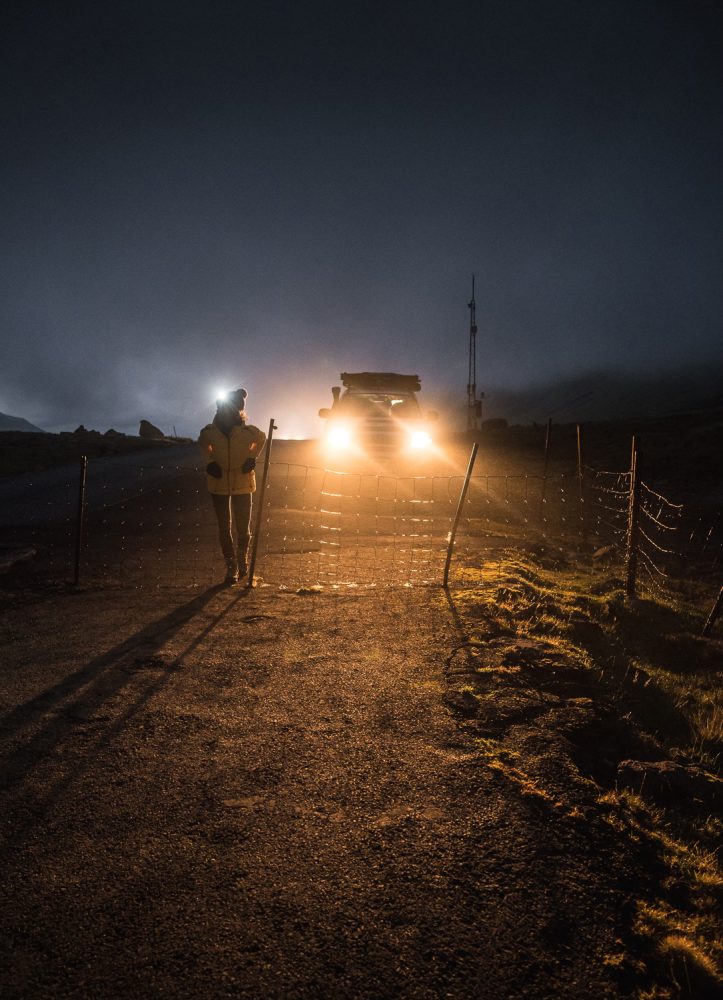
Faroe Islands Accommodation
Whether you prefer to camp, self-cater in an Airbnb, bed down in a hostel (Giljanes is excellent), guesthouse, or hotel, there’s an option that will cater to all budgets. Contentiously, the Hilton is poised to become the first international hotel brand in the Faroes. With a rooftop tent atop our rig, we had a choice of 20 campsites (camping.fo) on six of the islands, including a football field. Alas, it’s prohibited to wild camp or sleep overnight in your vehicle.
Money
Bring a combination of Apple Pay, credit card (chip and PIN are required on occasion, American Express is not widely accepted), and krone (Faroese or Danish are of equal value)—the latter if you plan on visiting the remote islands where only cash is accepted. Although a handful of places in the bigger towns accept foreign currency, the exchange rate will likely be unfavourable. You’re better off withdrawing your hard-earned moolah at widely available ATMs.
Cultural Considerations
What is it to be Faroese? It’s a constant conversation about the weather, knowing every person who walks down the lane (and probably their cousin, too), and never leaving your friend’s house hungry. They’re a people that hunt the local birdlife and still engage in whaling to consume the meat and blubber. Yet, they’re striving for solely renewable energy by 2030 and have embraced a dynamic LGBT movement.
Do’s
- Talk to the locals as they are friendly and hospitable.
- Save more money than you think you’ll need as this is no budget destination. Cram as many firsts, fresh experiences, and at least one tour in the time and budget available.
- Keep to allocated paths and roads on foot or in a vehicle, respectively.
- Bring your drone (visitfaroeislands.com/plan-your-stay/practical-information-2/drones/).
Don’ts
- Broach the subject of the annual Grindadráp, the Faroese whale hunt. Residents are not keen to engage in dialogue with outsiders who feel affronted by it.
- Trespass or ramble in cultivated grass fields; farmers privately own the majority of land in the Faroes on which grazing areas grow from May through August.
- Veer too close to cliff edges; there are countless steep, windswept, and precarious ones, some with 400-metre drop-offs.
- Disturb bird nests.
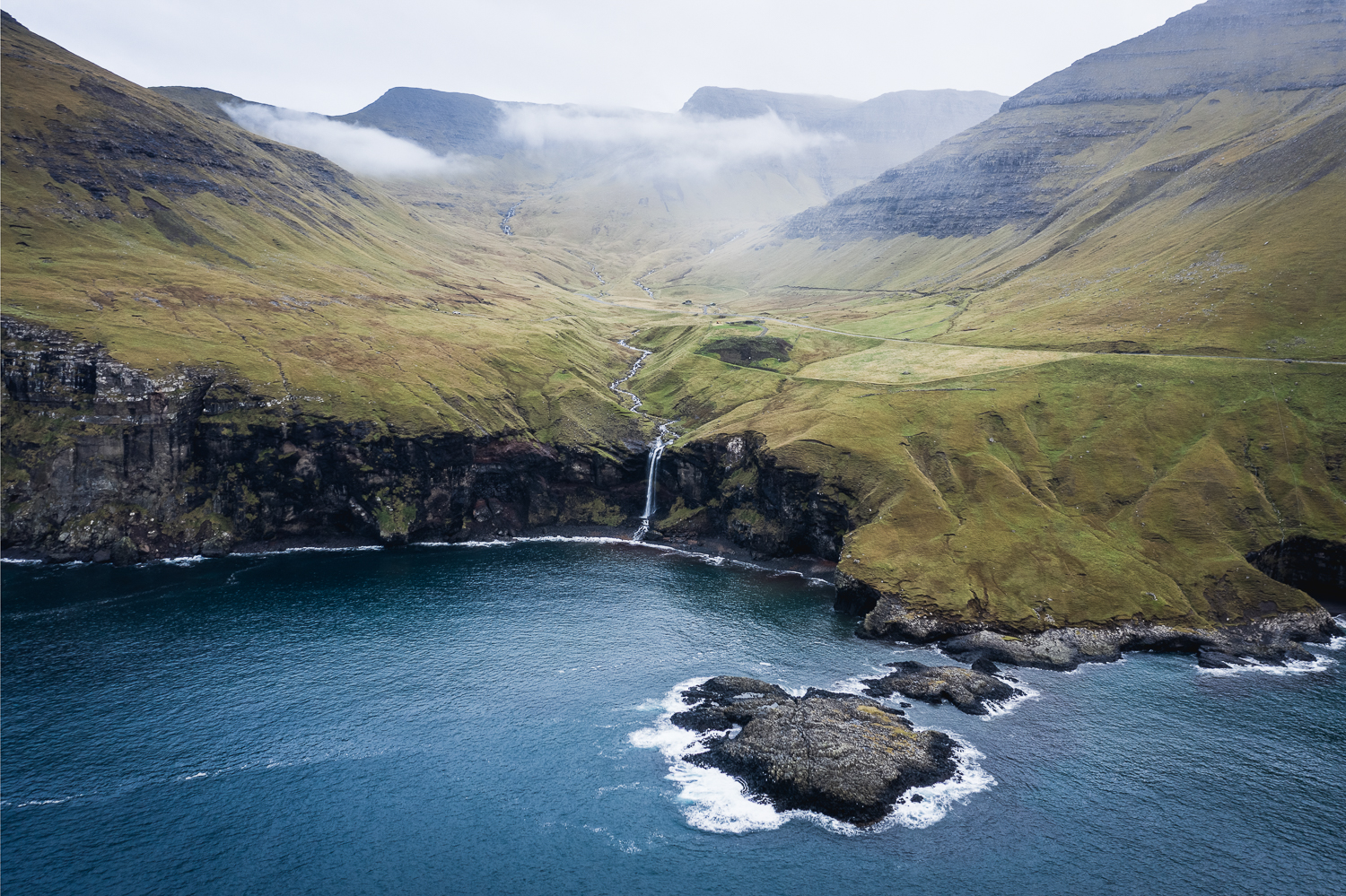
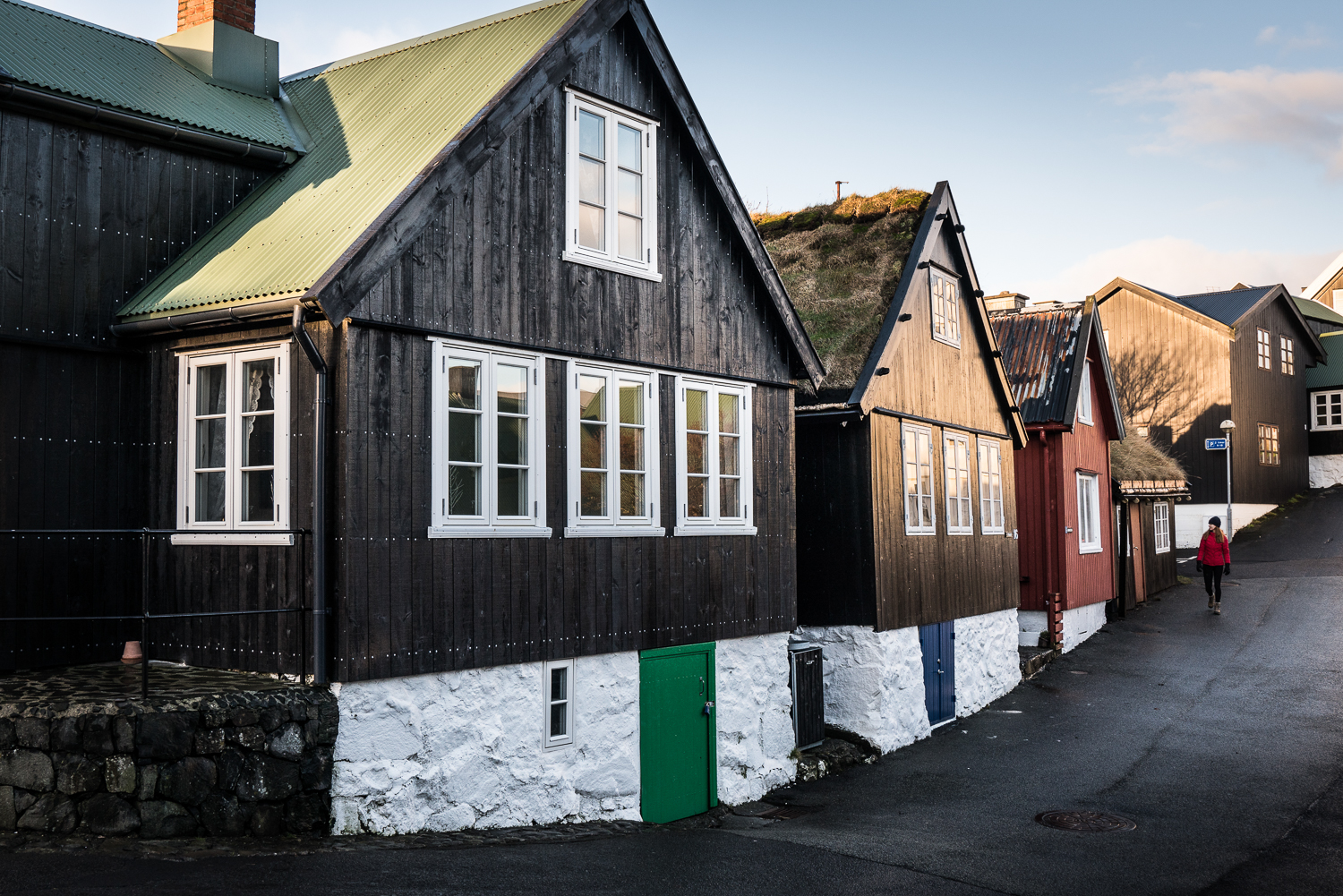
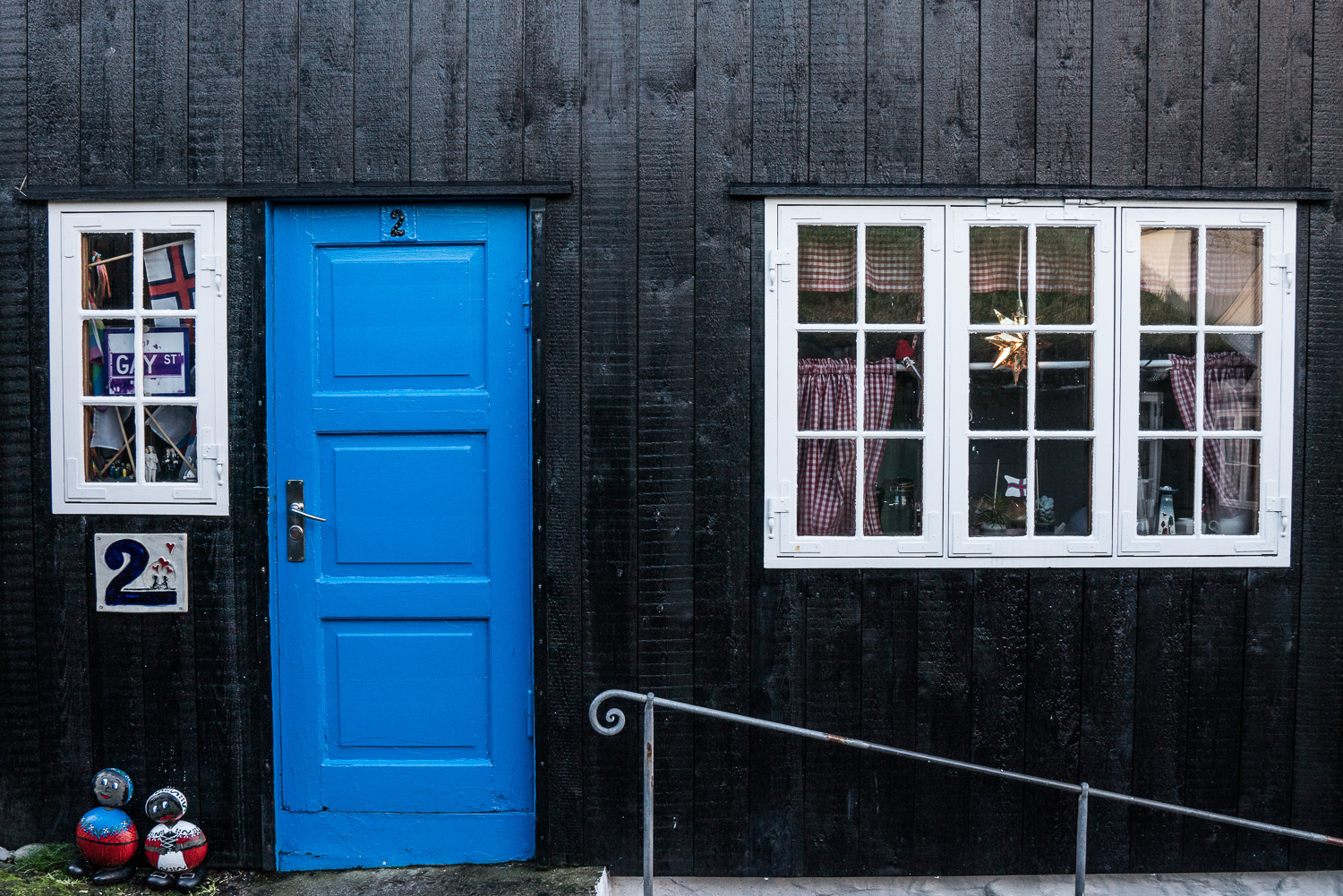
Language
Similar to most Scandinavian countries, English is widely spoken. As a North Germanic language descended from Old Norse, Faroese is a first language to no more than 80,000 people today and is as daunting as learning Icelandic. There’s no Faroese on Google Translate; check out faroeislandstranslate.com instead. Interestingly, Faroese boasts nearly 40 words for fog, and the national language is featured on milk cartons to preserve it from extinction. Other than uttering takk (thanks, pronounced tahk), we found everyone spoke perfect English. That said, it always bodes well with locals to have the basics up your sleeve.
- Hi – Hey
- Excuse me – Orsaka (Orsh-akha)
- Do you speak English? – Tosar Tú Enskt? (Toah-sar Too Enskt?)
- One beer – Eina Øl (Eye-nah Uhl)
Food and Drink
I never need an excuse to chow down the local cuisine. Bumping into Roman, a two-Michelin-star chef at Koks one day, I happened to sample a raw scallop, langoustine brains, and a piece of sea cabbage plucked straight from the Atlantic just moments before. Far from what my taste buds expected, the platter was delicious. If avant-garde style brains and cabbage isn’t your idea of a culinary marriage, you can lunch with Faroese farmers, Oli and Anna ($150, visittorshavn.fo). Otherwise, Tórshavn boasts an impressive array of dining for its size. Namely, rustic dining, sushi, fish and chips, pizzerias ($20+ for a large pizza), Mediterranean, and Chinese.
Gloriously, there’s a string of inviting pubs in the capital when you fancy a pint. Beer lovers will want to sip the 125-year-old, prize-winning Føroya Bjór or Okkara beers from two of Scandinavia’s oldest breweries whose ingredients include rhubarb and angelica. Cheers!
Adventure on the Faroe Islands
Excursions and tours which are packaged, activity-based, themed, and grouped are available online or via information centres. The more adventurous experiences vary from abseiling a 656-foot cliff (on Sandoy) into the sea and swimming ashore, paddling around the islands, and diving the crystal clear waters year-round. Riding the waves in Tjørnuvík is a winter sport, gathering world-class surfers in extreme weather. If that’s not your bag of fun, horse riding over the grassy mountains might be. Search for activities by island.
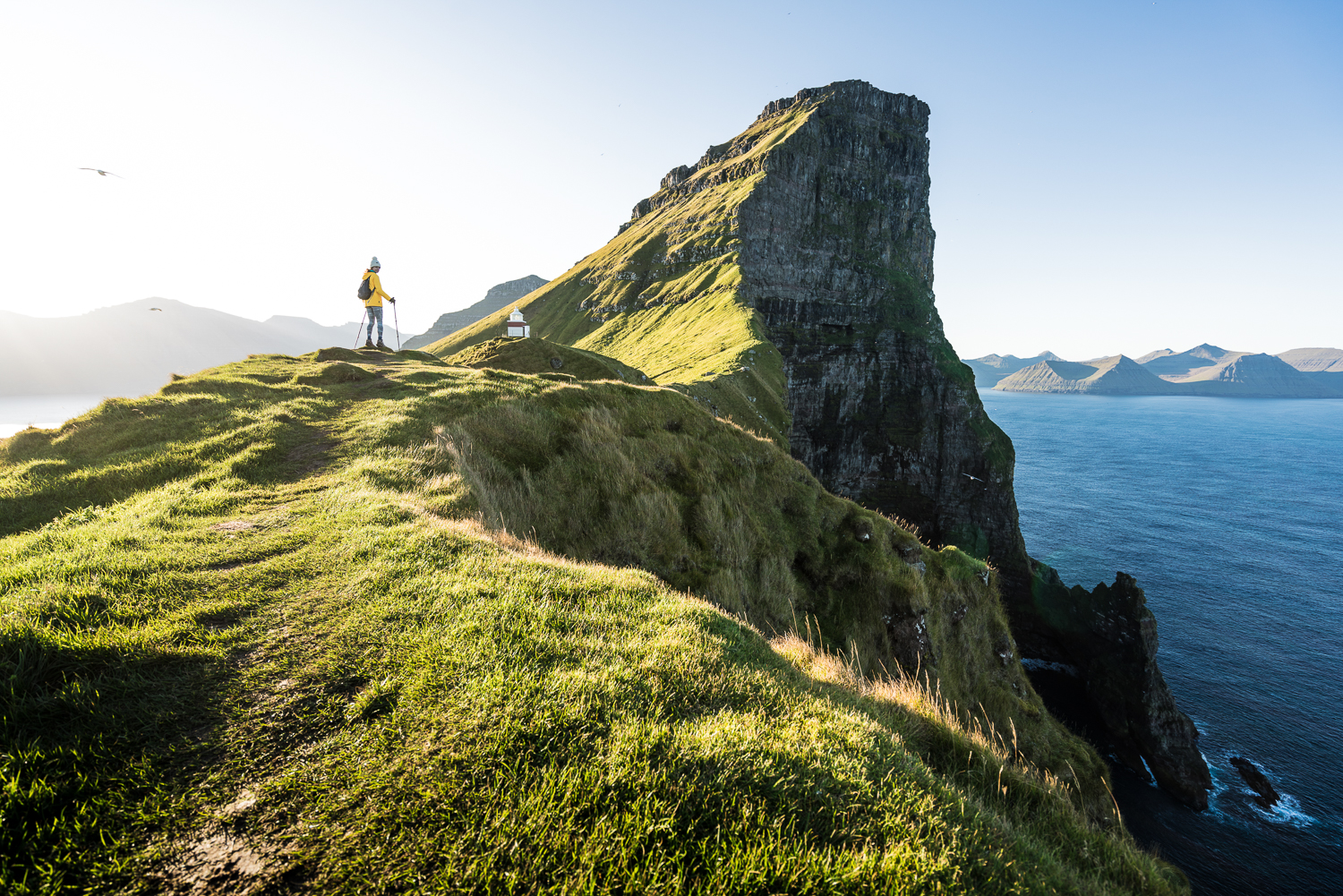


Hiking
Not exactly inundated with an extensive network of trails, the Faroes are still a hiking paradise. Within the archipelago, there are 687 miles of flawless coastline lining big expanses of lush countryside. Slættaratindur, the Faroes’ highest mountain at 880 metres (2,887 feet), boasts the highest vantage point of all the islands. Enveloped in unspoilt nature, you can wander the ancient paths marked by cairns toward rocky pillars such as Trøllkonufingur (the Witch’s Finger on Vágar) or stay on the scenic route to the next village.
Must-do’s include rambling around Streymoy; Saksun is a shire-like hamlet straight from Middle Earth in a natural amphitheatre high above a tidal lagoon. Vistas stretch in every direction, and old Viking houses dot the island. Suduroy’s Hvannhagi is a beautiful spot affording magnificent views of two small but striking islets, and Beinisvørð is known for its panoramas, birdlife, and the surf at sunset. The arch of Drangarnir—its ridgeline is akin to a dragon’s spurs—reminds us that nature is all that matters. (A guided six-hour return hike to Drangarnir is $85, but offer the owner a fair price to go unguided, and there’s a good chance he will accept. See tralanipan.fo.)
As mentioned, all the land is privately owned, so there’s no right to roam. The nearest information centre will relay any restrictions about entry. Directional signage is usually in place at a trailhead, along with a coin-raking turnstile accessed via a contactless credit card machine. Either way, shaggy sheep and hardy seabirds will surround you. (Unguided treks from $8 to $33.)
Favourite Sunrise Hike: Lake Sørvágsvatn
Located on Vágar, ambling to Lake Sørvágsvatn cost us an hour on foot and $30 per person. (Guided treks are circa $72 at tralanipan.fo). After taking one of two gravel roads, the trailhead began on the outskirts of Miðvágur at a small parking area. If a car can’t get you there, bus 300 from Tórshavn will (ssl.fo). Sørvágsvatn is the Faroes’ largest lake spilling out into the sea via Múlafossur, a plunging 130-foot waterfall. The greater height of the cliffs at Trælanípan, which flanked the waterfall, gave rise to a striking illusion that the lake was perched high above the sea, tilting outwards.
Boat Trips
Being in the open North Atlantic is another worthy way of experiencing the Faroes. Whether that entails jumping aboard an old schooner to go deep-sea fishing; listening to the puffins, guillemots, and razorbills (all favourites at the Faroese dinner table) at hotspots Vestmanna, Mykines, or Søltuvík; or cruising through the narrow straits. Perhaps go to a “grotto concert” inside a cave to hear jazz at sea or just island-hop. Sightseeing cruises are $46-$157 (guidetofaroeislands.fo).
Entertainment
The streets in Tórshavn are a hub of cosy cafes, and there’s a good vibe at the marina, Vágsbotnur, where you’ll become acquainted with independents selling handicrafts and woollen jumpers. Take a stroll through the intricate lanes of Tinganes, a tiny Old Town, to Vaglid Square, where you’ll find Lagtinget (parliament), and the pedestrian area begins. An old cinema showcases 3D films; museums and the Nordic House are packed with Scandinavian culture and spirit. What’s more, a plethora of festivals draw in music lovers, including the G! and the Summarfestivalurin.
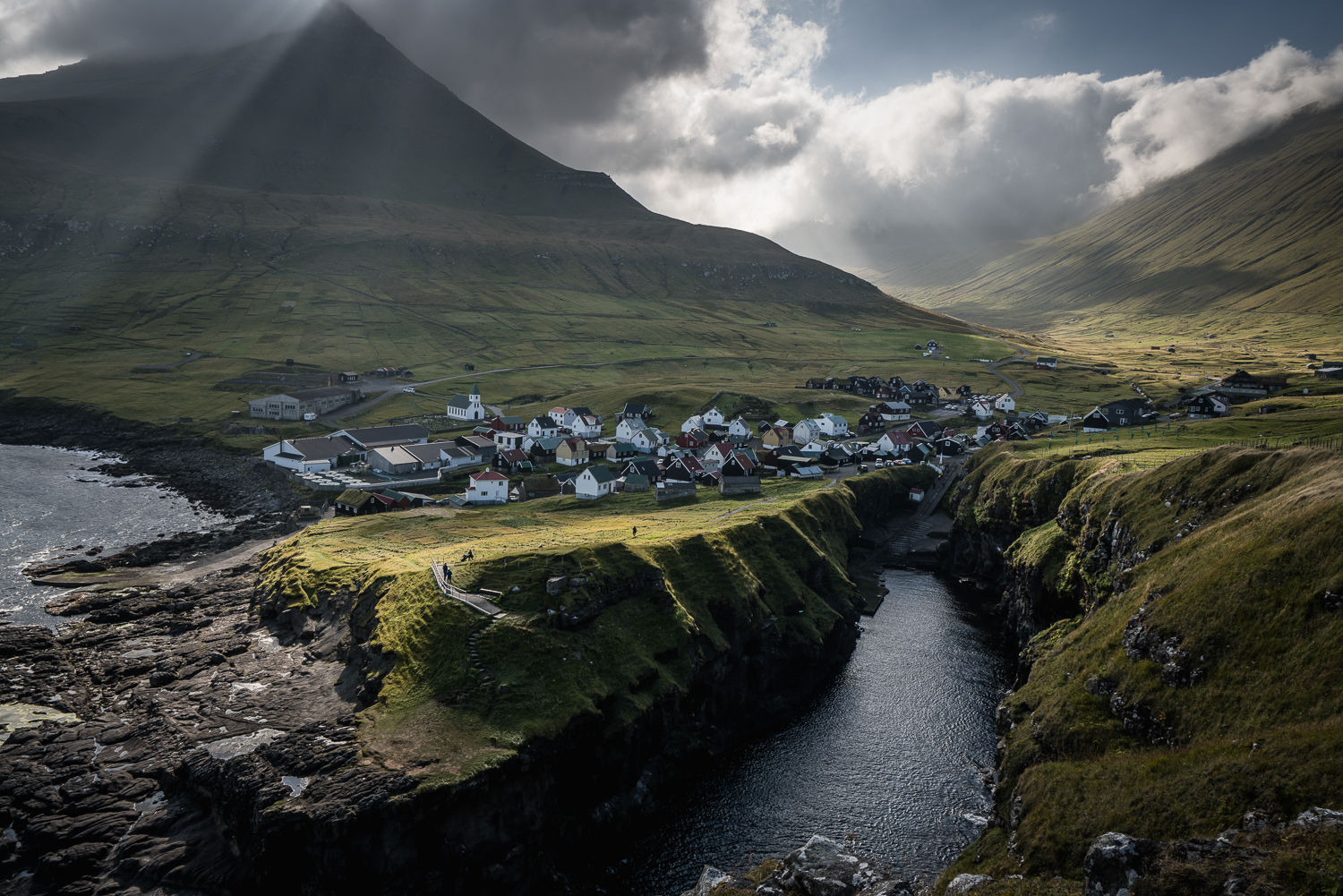
Resources
Guide to Faroe Islands guidetofaroeislands.fo
Visit Faroe Islands visitfaroeislands.com
Faroese language course faroeseonline.com
A Faroes’ first-timer’s guide roughguides.com/article/a-first-timers-guide-to-faroe-islands
Faroes travel tips, itineraries thecommonwanderer.com, search Faroe Islands
If the ocean views of the Faroe Islands have inspired you, check out this definitive guide to photographing water, also by Lisa Morris.
Our No Compromise Clause: We carefully screen all contributors to ensure they are independent and impartial. We never have and never will accept advertorial, and we do not allow advertising to influence our product or destination.


